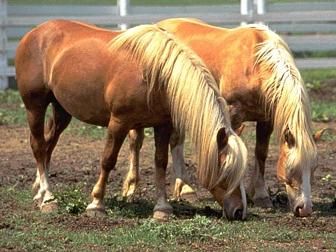
OVERVIEW
The Haflinger is quite similar to the Avelignese breed of Italy, where the Haflinger was originally bred prior to World War I. The Haflinger is noted for its ability to climb in steep mountain regions with agility. It has traditionally been used as a pack horse in the mountains, but it is also used in forestry and light agricultural work. Austrian farmers are allowed to keep mares, but stallions are owned by the state and are kept as studs. Only the finest stallions are allowed to breed and, therefore, the quality and purity of the breed is excellent. The Haflinger is noted for its great strength relative to its size, its handsome appearance and a gentle disposition.
PHYSICAL DESCRIPTION
One of the prominent and most consistent characteristics of the Haflinger is its color. It is always chestnut, in varying shades, and the mane and tail are consistently flaxen or cream-colored. White markings are acceptable. The head is large with wide-set eyes. The neck is substantial and the mane is, if not clipped, long and full, as is the tail. The body is relatively long and the back is broad; the chest is full. It has powerful quarters and short legs with a limited amount of feather about the fetlocks. It stands at about 14 hands. It is noted for its longevity.
ORIGIN
This is an ancient breed which, some historians assert, is derived from horses brought to the northern provinces of Rome by Goths about 555 AD. In any case, the Haflinger was originally bred in the District of Hafling, near Moreno in Italy (Austria ceded this area to Italy after World War I). The Haflinger's Italian counterpart is the Avelignese. The breed is now bred in Austria and the government owns stud farms at Piber and Ossiach where the stallions are kept. The Haflinger combines a heritage of Coldblooded and Oriental ancestors.
INTERESTING FACTS
In recent years the Haflinger has enjoyed a great deal of popularity, and it is being exported to other countries, particularly Great Britain. It has proven to be an excellent mount for the novice rider.
INFLUENCES
1. Forest Horse
2. Noriker
3. Arabian
For more information:
American Haflinger Registry